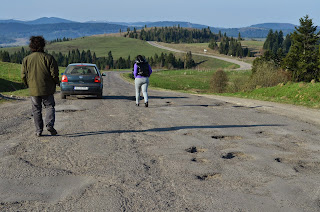The road in Ukraine was bad, our speed was about 40-50 km per hour and the traffic was scarce.
We were getting hungry, so we stopped at the first restaurant on the roadside. They served us a very tasty and inexpensive meal (the boys played chess while we were waiting for it) but while looking at the place, its visitors and their cars we kept on wondering whether it wasn't run by some shady guys...
We crossed tiny villages and churches with their golden roofs shining in the late afternoon sun. All trees were in flower and there was no piece of land left uncultivated. As Ukrainian wages are very low and roads are extremely bad, the traffic was very scarce. The road was getting worse and worse and we were advancing extremely slowly. We had about 120 km in front of us to the nearest town but we decided to continue the journey only the next day. So we stopped at the very first inn and asked for accomodation. They charged us 6 euro per person and we slept in a nice wooden chalet with all the comfort we needed. We met a group of young people from Kiev who were on a trip, some of them spoke very good English and were of great help in communicating with the locals. I still keep in touch with one of them: Olga, a young artist. We drank a few beers and some local vodka and went to bed.
Because of the condition of the road the next morning we started very early and without waiting for the staff to wake up to make breakfast for us. We advanced with the painstaking speed of 12-15 km per hour. We had to get out of the car very often to protect its bottom. There was almost no traffic at all, the air was fresh and clear, the landscape very beautiful.
We were crossing a national park and we saw deer, foxes, rabbits and hunting birds on our journey. We stopped in Uzhok, a larger village to buy some breakfast. The simple village shop looked and smelt just like the ones in communist Romania. Marcel Proust was right: it is amazing how certain smells awake the memories of the past. We stepped into this small shop and I could suddenly picture the one in the village where I spent the vacations in my childhood.
Speaking Russian in Ukraine is not very appreciated right now, and I don't speak much Russian anyway. But one thing is true: if you speak one Slavonic language, you'll understand the rest. My Croatian is far from perfect but is very helpful when I have to deal with people who only speak Ukrainian or Russian. The shopkeeper was a very nice lady who suggested some freshly baked doughnuts filled with sausages. They warmed it for us in the microwave oven and gave us napkins. We asked for some kefir and we had a delicious breakfast. Village people were coming and going on the road while we were eating. We were the first foreigners seen within months probably, tourists don't just walk around like in other parts of Europe.
The meeting point of two counties (oblast) is marked by a barrier guarded by armed policemen. We were stopped, our car and papers were checked. It seemed that they were looking for a reason to make us pay. We telephoned our friends' friend, a journalist who explained them that we were journalists too (well, at least our friends are...), so they allowed us to pass.
The road improved as we approached Uzhgorod (Ungvár in Hungarian), our next stop. We walked through the city a bit and took some time to get a good look of the bridge decorated with lovers' locks. We also have such a bridge in my hometown but it's a far cry from this one. Ukrainians are serious about love, or at least about showing it to the world. As we were about 1000 km from the warzone, the large number of soldiers walking up and down the city were the only sign of the ongoing conflict.
We continued our journey to Mukachevo (in Hungarian: Munkács).They have a pretty castle on the top of a hill which played an interesting role in Hungarian history. We had a very forgettable meal in an expensive restaurant with really bad service. As it was our next stop, we went into a shop to buy a few things. Ukrainian vodka is really good, so I asked for a bottle of Horticia, the only brand I was familiar with. The lady at the counter put the bottle in front of me and said: this is made in Harkov (a town situated in the Russian inhabited part of the country), why don't you buy a vodka made here, around Lviv? It is also good, and it is ours. I was a bit surprised (also because I understood the sentence without problem) but then I said to myself: ok, why not? And we bought the other bottle too. But I was surprised to encounter such a reflection of ethnic tensions.
I liked Ukraine very much, it reminds me of Romania as it was 25 years ago. It is affordable even for us, I liked the landscape, the people, the food and I'm already making plans to go back to visit Lviv and its surroundings, and to look for the grave of a family member of mine who died here during the 1st World War and is buried around Stryj somewhere. Traveling by car is not a wise option but we don't have a car anyway. Buses and trains are very old but I don't mind. So I hope to see you soon, Ukraine.





















































